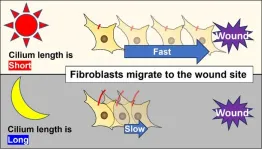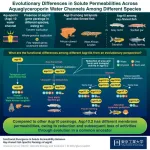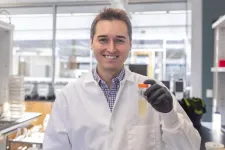(Press-News.org) Increased sedentary time as a child through adolescence is directly linked to childhood obesity, but new research has found light physical activity may completely reverse the adverse process.
The study - conducted in collaboration with between University of Exeter, University of Eastern Finland, University of Bristol, and University of Colorado and published in Nature Communications – is the largest and longest follow-up to objectively measure physical activity and fat mass, using the University of Bristol’s Children of the 90s data (also known as the Avon Longitudinal Study of Parents and Children). The study included 6,059 children (53 percent female) aged 11 years who were followed up until the age of 24.
Recent reports concluded that more than 80 percent of adolescents across the globe do not meet the World Health Organization’s (WHO) recommended average of 60 minutes a day of moderate-to-vigorous physical activity. It is estimated that physical inactivity will have caused 500 million new cases of heart disease, obesity, diabetes, or other noncommunicable diseases by 2030, costing £21-million annually. This alarming forecast regarding the morbid danger of physical inactivity necessitates urgent research on the most effective preventive approach.
Yet results from this new study shows that moderate-to-vigorous physical activity is up to ten times less effective than light physical activity in decreasing overall gain in fat mass.
Dr Andrew Agbaje of the University of Exeter led the study and said: “These new findings strongly emphasise that light physical activity may be an unsung hero in preventing fat mass obesity from early life. It is about time the world replaced the mantra of ‘an average of 60 minutes a day of moderate-to-vigorous physical activity’ with ‘at least 3 hours a day of light physical activity’. Light physical activity appears to be the antidote to the catastrophic effect of sedentary time in the young population.”
During the study, a waist-worn accelerometer measured sedentary time, light physical activity, and moderate-to-vigorous physical activity among participants at ages 11, 15, and 24 years. Dual-energy X-ray absorptiometry-measured fat mass and skeletal muscle mass were also collected at the same ages and fasting blood samples were repeatedly measured for glucose, insulin, high-density lipoprotein cholesterol, low-density lipoprotein cholesterol, triglyceride, and high-sensitivity C-reactive protein. In addition, blood pressure, heart rate, smoking status, socio-economic status, and family history of cardiovascular disease were measured and controlled for in the analyses.
During the 13-year follow-up, sedentary time increased from approximately six hours a day in childhood to nine hours a day in young adulthood. Light physical activity decreased from six hours a day to three hours a day, while moderate-to-vigorous physical activity was relatively stable at around 50 minutes a day from childhood through young adulthood.
It was observed that each minute spent sedentary was associated with a 1.3-gram increase in total body fat mass. Both male and female children gained an average of 10kg of fat mass during growth from childhood until young adulthood. However, sedentary time potentially contributed 700 grams to 1kg of fat mass (approximately seven to ten percent) of the total fat mass gained during growth from childhood until young adulthood. A 1kg increase in fat has been linked to a 60-percent higher risk of premature death in a person’s early 50s.
Each minute spent in light physical activity during growth from childhood through young adulthood was associated with a 3.6-gram reduction in total body fat mass. This implies that cumulative light physical activity decreased total body fat mass by 950 grams to 1.5kg during growth from childhood to young adulthood, (approximately 9.5 to 15 percent decrease in overall gain in fat mass during the 13-year observation period). Examples of light physical activity are long walks, house chores, slow dancing, slow swimming, and slow bicycling.
In contrast, time spent in moderate-to-vigorous physical activity - including meeting the 60 minutes a day recommended by the WHO - during growth from childhood through young adulthood was associated with 70 to 170 grams (approximately 0.7 to 1.7 percent) reduction in total body fat mass. Prior to this study, it has not been possible to quantify the long-term contribution of sedentary time to fat mass obesity and the magnitude by which physical activity may reduce it. But this study confirmed the report from a recent meta-analysis of 140 school-based randomised controlled trials across the globe that engaging in moderate-to-vigorous physical activity had minimal or no effect in reducing childhood BMI-obesity.
Dr Andrew Agbaje of the University of Exeter said: “Our study provides novel information that would be useful in updating future health guidelines and policy statements. Public health experts, health policymakers, health journalists and bloggers, paediatricians, and parents should encourage continued and sustained participation in light physical activity to prevent childhood obesity.”
The paper entitled ‘Effects of Accelerometer-based Sedentary Time and Physical Activity on DEXA-measured Fat Mass in 6059 Children’ is published in Nature Communications.
Dr Andrew Agbaje’s research group (urFIT-child) is supported by research grants from Jenny and Antti Wihuri Foundation, the Finnish Cultural Foundation Central Fund, the Finnish Cultural Foundation North Savo Regional Fund, the Orion Research Foundation, the Aarne Koskelo Foundation, the Antti and Tyyne Soininen Foundation, the Paulo Foundation, the Yrjö Jahnsson Foundation, the Paavo Nurmi Foundation, the Finnish Foundation for Cardiovascular Research, Ida Montin Foundation, Eino Räsänen Fund, Matti and Vappu Maukonen Fund, and the Foundation for Pediatric Research.
ENDS
END
Light exercise could be the key to reversing childhood obesity linked to sedentariness
Increased sedentary time as a child through adolescence is directly linked to childhood obesity, but new research has found light physical activity may completely reverse the adverse process.
2023-12-21
ELSE PRESS RELEASES FROM THIS DATE:
Are diamonds GaN’s best friend? Revolutionizing transistor technology
2023-12-21
Researchers at Osaka Metropolitan University are proving that diamonds are so much more than just a girl’s best friend. Their groundbreaking research focuses on gallium nitride (GaN) transistors, which are high-power, high-frequency semiconductor devices used in mobile data and satellite communication systems. With the increasing miniaturization of semiconductor devices, problems arise such as increases in power density and heat generation that can affect the performance, reliability, and lifetime of these devices. Therefore, effective thermal management is crucial. Diamond, ...
New study examines the relationship between the rate of wound healing, the circadian rhythm, and ‘hair’ on cells
2023-12-21
Nearly every organism on Earth follows a natural circadian rhythm that is coded by your cell’s clock genes, which do exactly as you suspect from the name: regulate your body’s rhythm on a 24-hour basis. Most cells in mammalian bodies have cilia of some sort, which are hair-like structures that perform a variety of functions such as movement for motile cilia and aiding in structure in function for non-motile, or primary, cilia. The primary cilia also act as a sensory organ for the cell, a function which has illuminated ...
Great British Bake Off Christmas desserts not as naughty as you may think
2023-12-21
Christmas desserts from The Great British Bake Off are more likely to use ingredients that are associated with reductions, rather than increases, in the risk of death or disease, suggests research published in the Christmas issue of The BMJ.
As the holiday season approaches, the age-old debate resurfaces: can we indulge in Christmas desserts without feeling the pang of guilt? Can we look past the negative headlines of what butter and sugar do to our bodies, and enjoy a piece of Christmas cake in heavenly peace?
To answer this Christmas conundrum, researchers set out to determine ...
Spike in morning after pill sales in the U.S. after New Year celebrations
2023-12-21
Sales of emergency contraception are estimated to rise by around 10% in the US in the week after the New Year holiday, suggesting that this period is associated with increased risks of unprotected sex compared with other holidays, finds a study published in the Christmas issue of The BMJ.
Other holidays such as Valentine’s Day and Independence Day were also associated with an increase in sales, but to a lesser extent.
Although this annual spike in sales might seem humorous, the researchers point out that as many US states have increased restrictions on abortion ...
The evolutionary timeline of diminished boric acid and urea transportation in aquaporin 10
2023-12-21
Aquaporin (Aqp) 10 water channels in humans allow the free passage of water, glycerol, urea, and boric acid across cells. However, Aqp10.2b in pufferfishes allows only the passage of water and glycerol and not urea and boric acid. Researchers from the Tokyo Institute of Technology sought to understand the evolutionary timeline that resulted in the variable substrate selection mechanisms among Aqp10s. Their results indicate that Aqp10.2 in ray-finned fishes may have reduced or lost urea and boric acid permeabilities through evolution.
Aquaporins ...
Wildflowers increasingly doing without insect pollinators
2023-12-21
Scientists at the CNRS and the University of Montpellier1 have discovered that flowering plants growing in farmland are increasingly doing without insect pollinators. As reproduction becomes more difficult for them in an environment depleted in pollinating insects, the plants are evolving towards self-fertilisation. These findings are published in a paper in the journal New Phytologist dated December 20, 2023.
By comparing field pansies growing in the Paris region today with pansies from the same localities resurrected in the laboratory from seeds collected2 between 1992 and 2001, the research team found that today's flowers are 10% smaller, produce 20% less nectar, and are less ...
Blue PHOLEDs: Final color of efficient OLEDs finally viable in lighting
2023-12-21
Dec. 20, 2023
Contact: Derek Smith, 734-546-3632, smitdere@umich.edu; Nicole Casal Moore, 734-709-1651, ncmoore@umich.edu
ANN ARBOR—Lights could soon use the full color suite of perfectly efficient organic light-emitting diodes, or OLEDs, that last tens of thousands of hours, thanks to an innovation from physicists and engineers at the University of Michigan.
The U-M team's new phosphorescent OLEDs, commonly referred to as PHOLEDs, can maintain 90% of the blue light intensity for 10-14 times longer than other designs that emit similar deep blue colors. That kind ...
Multitasking microbes: UW–Madison scientists engineer bacteria to make two valuable products from plant fiber
2023-12-20
We often look to the smallest lifeforms for help solving the biggest problems: Microbes help make foods and beverages, cure diseases, treat waste and even clean up pollution. Yeast and bacteria can also convert plant sugars into biofuels and chemicals traditionally derived from fossil fuels — a key component of most plans to slow climate change.
Now University of Wisconsin–Madison researchers have engineered bacteria that can produce two chemical products at the same time from underutilized plant fiber. And unlike humans, these ...
And now, your community health forecast…
2023-12-20
In the not-so-distant future, people might be able to tune in to their favorite news source for an update on their community health status, just as they check on the local weather forecast.
The community health status is similar to the color-coded Doppler weather data that provides meteorologists with information about rain, snow or hail, its motion and intensity, which they can use to determine specific areas where dangerous weather conditions exist. Having this information has proven to be a valuable tool to protect life and property.
“The new community ...
A framework in your brain for organising the order of things
2023-12-20
Scientists at NTNU’s Kavli Institute for Systems Neuroscience in Norway have discovered a pattern of activity in the brain that can serve as a template for building sequential experiences.
“I believe we have found one of the brain’s prototypes for building sequences” says Professor Edvard Moser.He describes the activity pattern as “a fundamental algorithm that is intrinsic to the brain and independent of experience.”
The breakthrough discovery was published in Nature 20. December 2023.
The ability to organise elements into sequences ...
LAST 30 PRESS RELEASES:
Manta rays create mobile ecosystems, study finds
Study: Mixed results in using lipoic acid to treat progressive multiple sclerosis
Norbert Holtkamp appointed director of Fermi National Accelerator Laboratory
New agentic AI platform accelerates advanced optics design
Biologists discover neurons use physical signals — not electricity — to stabilize communication
Researchers discover that a hormone can access the brain by hitchhiking
University of Oklahoma researcher awarded funding to pursue AI-powered material design
Exploring how the visual system recovers following injury
Support for parents with infants at pediatric check-ups leads to better reading and math skills in elementary school
Kids’ behavioral health is a growing share of family health costs
Day & night: Cancer disrupts the brain’s natural rhythm
COVID-19 vaccination significantly reduces risk to pregnant women and baby
The role of vaccination in maternal and perinatal outcomes associated with COVID-19 in pregnancy
Mayo Clinic smartwatch system helps parents shorten and defuse children's severe tantrums early
Behavioral health spending spikes to 40% of all children’s health expenditures, nearly doubling in a decade
Digital cognitive behavioral treatment for generalized anxiety disorder
Expenditures for pediatric behavioral health care over time and estimated family financial burden
Air conditioning in nursing homes and mortality during extreme heat
The Alps to lose a record number of glaciers in the next decade
What makes a good proton conductor?
New science reporting guide published for journalists in Bulgaria
New international study reveals major survival gaps among children with cancer
New science reporting guide published for journalists in Turkey
Scientists develop a smarter mRNA therapy that knows which cells to target
Neuroanatomy-informed brain–machine hybrid intelligence for robust acoustic target detection
Eight SwRI hydrogen projects funded by ENERGYWERX
The Lundquist Institute and its start-up company Vitalex Biosciences Announces Strategic Advancement of Second-Generation fungal Vaccine VXV-01 through Phase 1 Trials under $40 Million Competitive Con
Fine particles in pollution are associated with early signs of autoimmune disease
Review article | Towards a Global Ground-Based Earth Observatory (GGBEO): Leveraging existing systems and networks
Penn and UMich create world’s smallest programmable, autonomous robots
[Press-News.org] Light exercise could be the key to reversing childhood obesity linked to sedentarinessIncreased sedentary time as a child through adolescence is directly linked to childhood obesity, but new research has found light physical activity may completely reverse the adverse process.





